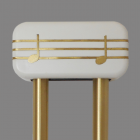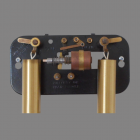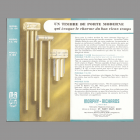Morphy Richards Clydon Chime

Morphy-Richards Clydon Tubular Doorbells Model T.U. 100
Morphy-Richards is a leading marketer of appliances in the the UK best known for electric kettles, blankets and light-weight clothes irons. In the 1950s Morphy-Richards marketed the Clydon Line of door chimes including the T.U.100 long bell model. Morphy-Richards distributed door chimes worldwide.
A variation on this model was available as the T.B. 101, a battery operated chime with a unique compartment between the two tubes that housed four D cell batteries, formerly known as U2 batteries in Europe.
This example was found in severely neglected condition. ElectraChime carefully restored the mechanism and fitted a new solenoid plunger and bells to factory specifications. Clydon chimes are particularly well made featuring a sophisticated scheme for adjusting the strike of the bells, a copper clad solenoid winding and elegant electrical terminals.
| Manufacturer | Morphy-Richards LTD |
| Location of Manufacture | St. Mary Cray, Kent, UK |
| Date of Manufacture | ~1950 |
| Cover | Painted stamped steel with brass ornaments |
| Mechanism | Steel |
| Bells | Brass |
| Width | 6 7/8 inches (17.5 CM) |
| Height | 38 inches (96.5 CM) |
| Depth | 2.25 inches (5.75 CM) |
| Notes | ElectraChime Collection |



I have one of these in our home in Melbourne Australia. The house was finished around 1950-1951.
The doorbell still works! We love it. Is it valuable?
Best wishes,
Richard
I have just had Morphy Richards Clydon chimes removed from wall during renovations. In the process I lost the armature/plunger, that’s the one moving part. I’d like to get a replacement. Does anyone know the exact dimensions of the original?
Hi, I have the exact same model as in the picture with silver, not brass tubes. It has been on the wall in our house for 17 years, it used to work however has not been used since disconecting the door bell 16 years ago. I am trying to get it to work again, there is an electrical current running live still from the transformer to the unit with a live wire running from it to where the doorbell used to be.
I have connected a new doorbell but alas, it will not operate, any help would be much appreciated in restoring it to it’s former glory.
Best regards
Mark Davies
Slaithwaite, west yorkhire, UK
Hello Mark, I sent some instructions via email. I’ve never seen a Clydon with silver colored tubes, please send a photo of your chime when you get it going again. Thanks.
Hi there, I have just savaged one of these doorbells and as Mark Davies mentioned ours has gold ribbon/music note detail but silver tubes.
The paint has is compromised so I’m repainting.
Do you have any guidance on best suited enamel colour to use? It seems to be more yellow than a lot of the cream epoxy enamels available (in Aus at least). Or perhaps the yellowing is contributed to by aging?
Congratulations. You have a nice chime. It’s difficult to know with certainty the precise color without an original paint code or contemporary photo. For guidance, please see the Morphy Richards T.C. 110 photos This was found new, old stock in it’s original wrapping and had seldom seen the light of day until recently. As photographed, it’s a cream color. A 1950’s Morphy Richards catalog describes both the T.C. 110 and T.U. 100 chimes as: (C)ellulosed (in) a deep shade of cream with tasteful silver or brass motif. I believe “cellulosed” is British English for a type of paint or lacquer.
I refinished the Museum example in a lighter Ivory color before I saw the old stock T.C. 110. Regardless, if a soap and water cleaning does not please you, I think you should follow your personal taste as any respray can be changed. Please send a photo when you finish and install your chime.
I restored my Grandfathers doorchime and the chimes were silver and also the music notes were silver and also the bar’s it’s in full working order and i am proud of it
Hi – our Clydon still works but intermittently! It looks as though the doorbell press outside has rusted up. I’ve tried cleaning it but with the same intermittent success. Is it possible to get a replacement doorbell press?
Hello, Any standard (unlighted) doorbell press will work. These are available at most any hardware store or DIY center.
More likely the fault is because of a sticky solenoid plunger. Remove the spring and plunger from the unit being careful not to lose any parts and note the orientation for reassembly. Clean the plunger with a clean abrasive pad like for dishes. Use a pipe cleaner or cotton swab to clean the inside of the brass sleeve being careful not to spill any solvent on the wire windings. Reassemble and never use oil. This procedure fixes 95% of the chimes with the trouble you describe. Let me know how it turns out. Robert
I have one with lacquered brass tubes, in fact i have 2 sets of them, both with different tones. It was my great grandmothers and had actually been in my grandmothers house since new. When she passed away in 1985 no one wanted it except me. Upon having my first house it went up. Needed a lot of de rusting. Still works after a bit of maintenance. As Dingdong said, any doorbell press works on it. If batteries are fully charged and it stops or gets “sticky” check the door buzzer, they tend to get a bit rusted sometimes.
Mine was given to my grandparents for their golden wedding in 1950 by my late brother and myself (we were 14 and 12 respectively). When they passed away it was moved to my parents’ house and finally to mine. It was recently not working properly but cleaning the terminals and re-making the connections did the trick. Since 1983 it has been powered by a Friedland transformer. I have just fitted a new illuminated bell push. As I use a transformer, it will not drain the battery. The bulb in a previous illuminated bell push failed after a few days because it was rated at 8 volts whereas the chimes are rated at 12. The current one is rated at 12 so we will see how long it survives.